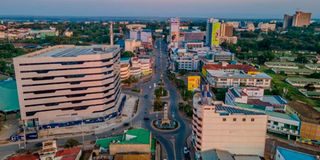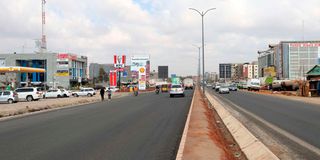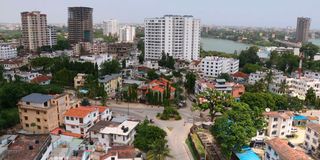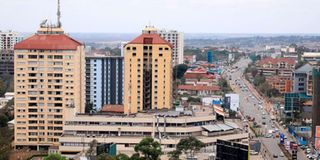
Kisumu's skyline with upcoming highrise flats replacing the old buildings.
Once upon a time, Kenyans used to scramble for certain suburbs. Then came their downfall.
And as is the norm with Kenyans, interests shifted and prices in these areas lagged. Buyer interests in suburbs and satellite towns are constantly undergoing silent reshuffles, often fuelled by price jumps, infrastructure developments and sometimes county government policies. While this random reshuffle and sprawl may have just worked well in the past, perhaps it's high time we take urban planning more seriously.
This week, we explore the current reshuffle; which suburbs are winning and which ones are losing. We also delve deep into the role of county policies, particularly, urban planning and how county governments can sustain investor confidence while controlling development - the biggest headache in the current real estate scene.
Price jumps and shifting policies
To understand current reshuffle trends, Peterson Mwangi, the Managing Director, Property Depot, a real estate agency in Kenya, sheds light on the topic: Mwangi says that over the past five years, the biggest suburb reshuffles have taken place in Kajiado, Thika Road and Kiambu Road.
"The leading locations where demand has tanked are in Kajiado. Suburbs like Kitengela used to be star destinations for buyers. Although locations like Rongai and Ngong still command buyer interests, county government policies and rapidly rising prices have gravely influenced declining demand.

Property Depot LTD Managing Director, Peterson Mwangi at his office in Nairobi on April 23, 2025.
Certain policies or pronouncements can make investors apprehensive, leading them to hold back. As expected, developers go where the demand is and when the demand goes down in a particular location, they move with their money. They do so to mitigate the risk of getting stuck with their units or struggling to complete their projects due to unpredictable policy changes".
Elsewhere in Kiambu, Mwangi notes Ruiru's popular Matangi place has been a darling for many buyers. Unfortunately, the location's prices have shot up rapidly, and people have started losing interest and looking for alternatives.
"Demand follows the normal curve, the higher the price, the lower the demand."
The winners
When it comes to winning suburbs, Mwangi notes, neighbourhoods along Thika Road in general are attracting high demand, while Kamakis has portrayed outstanding performance with a persistent winning streak.
"One of the contributing factors is the dualling of the Eastern bypass which began in November 2021. Expansion of the bypass made the location more accessible while friendly property prices turned it into a commercial hub which further fueled its appeal".

Kamakis has portrayed outstanding performance with a persistent winning streak.
On the other side of Kiambu, Mwangi says, Kikuyu has also become a hotspot for investors in the last few years. The Southern bypass has played a critical role in encouraging buyer demand.
"People working along Mombasa road can easily live in Kikuyu and avoid all the traffic. Kikuyu is attractive to all kinds of investors, but buyers looking for residential homes are attracted to the available amenities, the nice, cool climate and the friendly property prices".
While infrastructure and property prices have been a key driving factor for buyer demand, locations along Kiambu Road seem to defy the "proverbial bubble bust" often fueled by unprecedented price jumps. Mwangi explains, Kiambu Road is very attractive to the upper middle class and it is curving a niche in high-end properties.
"Accessibility through feeder roads and social amenities have really shaped the Kiambu road market. There are high-end schools, malls, hospitals and other social amenities. Its proximity to Nairobi's CBD is a great selling point. Unlike most other locations, affordability has not affected the demand because people are now going for the prestige or class this market offers. Kiambu Road is the next high-end location after Nairobi's prime estates".

Some high rise building in Tudor area of Mombasa City. As high-rise buildings proliferate and modern urban planning takes root, concerns are mounting that the city's unique cultural identity is fading under the weight of modernisation.
While these patterns are based on market observation, recent data captures similar trends. According to the Housing Survey Report launched in January, 2025 by the Kenya National Bureau of Statistics (KNBS), 17 percent of tenants seeking homeownership would like to settle in Nairobi. Nairobi may be unaffordable to many, therefore, Kiambu comes in second as the most preferred county by aspiring homeowners at 8.6 percent. Nakuru, Machakos and Mombasa follow closely at 6.6 percent, 5.1 percent and 4.6 percent, respectively. Despite being highly accessible as part of the metropolis, Kajiado comes in at number six with 4.0 percent of tenants preferring the county as a future home.
Periodic shifts
On whether a suburb's shine can be restored, Mwangi explains, demand shifts tend to be periodic and there are several factors that can redirect buyers' interests to a location. For instance, when investors lose interest in a location, the prices lag behind and over time, the location becomes affordable, compared to other areas that had not lagged - such price lags tend to attract investors later on. Sometimes new amenities come up during the quiet years and that drives buyers back to the location.
If the location is attracting entertainment seekers visiting recreational facilities, these visitors or tourists will be reminded of the location's land or housing market and consider buying if it's cheaper, compared to other locations with similar amenities and accessibility.
Reactive urban planning
As we've seen above, Kenya's real estate market is driven by infrastructure development and affordability. In some cases, Mwangi points out, infrastructure follows the population. While this may seem normal to non-planning experts, it's not sustainable.
"Kenya is not very proactive in shaping urbanisation through planning. Many of the hotspots growing rapidly are influenced by privately built amenities and unplanned settlements. Public infrastructure tends to follow populations. When people establish themselves in a settlement they pressure local governments to develop infrastructure and amenities. And in scenarios where people have settled in a place due to transport-related developments, the feeder roads and other infrastructure tend to be in deplorable conditions. The county governments need to support mega infrastructure and properly plan growth".
Planning is especially important now that Kenyan buyers, especially the middle class, are looking for value for money. Sporadic and unplanned development is no longer tolerated.
To understand how County governments can use urban planning to create better, controlled urbanisation that sustains investor confidence, and sprawling economies, DN2 Property spoke to Mairura Omwenga a Civil/ Structural Engineer, a town planner, and a Lead Environment Impact (EIE) Assessment Expert and the Chairman, Town and County Planners Association of Kenya (TCPAK), He is also a Lecturer at the University of Nairobi and a Member of the International Society of City and Regional Planners (ISOCARP - based in the Hague, Netherlands).
Omwenga explains that urban or town planning is undertaken by planners or land use planners, who in other jurisdictions, are referred to as physical planners.
"Their responsibility is to shape how land is used. The foundation of the profession is in the early towns when we had various activities in urban areas. These activities include housing development, commercial activities, industries, social services or public facilities, education institutions, open spaces, recreation, green spaces and utilities. You may also find agriculture in some towns, including Nairobi. Then there is a transport network in every town. All these activities are taking place on land and they compete for the land to thrive. In planning, we refer to them as land uses".
The work of a town planner, then, is to determine the best use of land at any given point. And when these activities are not planned, they cause conflict. For instance, housing developments placed near industrial zones can cause conflicts over industrial waste affecting residents.
Planners also determine the best location for different activities, such as roads, industries, commercial centres and housing depending on the town's orientation. Finally, having determined these two things, Omwenga further explains, planners have to determine how much land should be allocated for different activities, noting that land is a limited resource.
Chaos vs compatibility
Urban planning is at the very heart of real estate growth in any county. Planning not only affects property values significantly, but it also ensures a town's growth is sustainable.
All these things come together to improve the local government's revenues while ensuring the residents and investors get value for their money. Poor planning or lack of implementation, on the contrary, leads to chaos and ultimately, dissatisfied investors, even when the infrastructure is present.
"If you look at an area like Kilimani, it was considered a high-income area and was well planned, initially. Now with more development and high density buildings overlooking lower-density homes, homeowners who had nice features like swimming pools may find it difficult to enjoy their use. The older low-density property owners are forced to sell and move out. And even when they decide to sell, they struggle to attract the right buyer".

A view of Kileleshwa estate.
Such growth trajectories are unsustainable. Town planning has short-term and long-term impacts and it plays a role in sustaining and enhancing property values. On one hand, economies can easily collapse due poor planning.
In recent years, counties within the metropolis have launched and published their plans. Just recently this month, Kiambu launched its new County Integrated Development Plan covering different zones in the county.
Nairobi has its Integrated Urban Development Master Pan while Kajiado also launched its 10-year Spatial Plan in 2023. As Omwenga above explains, these documents are often publicly available and act as a marking scheme that regulates development in different zones.
"Every town worth its name should have development plans. These plans provide the standards of what needs to be done at what time. If a town grows without a development plan, it is difficult to control development, therefore when a developer comes to invest, they check the prescribed land use guidelines for respective zones. These plans also guide county authorities in approving building plans”.
Omwenga points out that developments are not just public documents, their drafters should invite public participation. "The constitution requires effective public participation in all areas of development," he says.
The challenge, however, is in implementing and adhering to these plans.
Implementation disconnect
"It is one thing to plan and another to implement it. We have many worthy development plans collecting dust on shelves".
In this case, county governments are not to blame, the general public and Kenya’s culture is the problem. As Omwenga observes, many people feel as if their rights and freedoms are being limited unnecessarily when such drafts are released. Also people often focus on personal interests, yet these plans are supposed to capture the greater public good. As a result, urbanisation becomes a tag of war between the local governments, residents and investors.

Mairura Omwenga,Chairperson of Town and County Planners Association of Kenya.
"It takes collective responsibility to implement development plans and shape development in a town. Most importantly, in any society there are governments which exist to protect the interests of the larger public and minimise private interests".
There is also a big gap when it comes to public participation. In many instances, residents are passive when invited to give views on development if they are not directly affected. People need to be more proactive in development control issues, as it affects their property values, lifestyles and other aspects of their lives.
With the rapid rural-urban migration and projected population growth, the metropolis is going to undergo increased pressure from new residents and new investors. Currently, county governments are struggling to balance between enticing new investments, while keeping existing residents happy.
Omwenga says, “Land use planning is all about balancing competing interests between different land uses. Industrial investors compete against housing or infrastructure, while residential settlements compete against agriculture. Such competition leads to sprawl. In towns like Kiambu or Machakos, development begins to extend to the agricultural areas where our food comes from.”
While this kind of sprawl is a welcome development for real estate enthusiasts, the question is - how far can urban sprawl go vis a vis agricultural areas, water sources and other essential resources?
Moving forward, Omwenga says it is important to first secure food baskets and minimise development toward the areas where we grow our food. This vision has been captured in Kajiado and Kiambu Counties’ Development plans.
However, when agricultural landowners weigh the financial gains of farming versus selling or developing their land, selling real estate is more lucrative.
“In some countries farmers are incentivised to maintain agricultural land. For example, if Kiambu's power is in coffee farming, the government can subsidise farm inputs or maintain stable prices so that farmers have a guaranteed market for their produce. This sustains the agriculture industry. Such interventions are important in controlling development and preventing urban sprawl,” says Omwenga.
Infrastructure development can also be used to redirect settlements, and this seems to be working well in Kenya. Roads and other infrastructure create an enabling environment for investors, directing them to focus on developing specific areas.
Harmonising development plans
Omwenga also strongly advises county governments in the metropolis to collaborate in integrating their development plans.
“The metropolis suburbs are now closely related and there are barely visible boundaries. People are working in Nairobi and sleeping in Kiambu, Kajiado or Machakos. Others live in Nairobi but seek investment opportunities in the suburbs. Nairobi County cannot develop its plan without making reference to the other counties that surround it.”









